As You Read, Compare and Contrast the Different Biomes by Completing Each Table Below
The biome concept organizes large-scale ecological variation. Terrestrial biomes are distinguished primarily by their predominant vegetation, and are mainly determined by temperature and rainfall.
Differences in temperature or precipitation determine the types of plants that grow in a given expanse (Figure 1). Mostly speaking, tiptop, density, and species diversity decreases from warm, wet climates to cool, dry climates. Raunkiaer (1934) classified found life forms based on traits that varied with climate. One such system was based on the location of the perennating organ (Table i). These are tissues that give rise to new growth the post-obit season, and are therefore sensitive to climatic weather. The relative proportions of dissimilar life forms vary with climate (Figure 2). In fact, life form spectra are more alike in similar climates on different continents than they are in different climates on the same continent (Effigy 3). Regions of like climate and dominant found types are called biomes. This affiliate describes some of the major terrestrial biomes in the world; tropical forests, savannas, deserts, temperate grasslands, temperate deciduous forests, Mediterranean scrub, coniferous forests, and tundra (Figure iv).
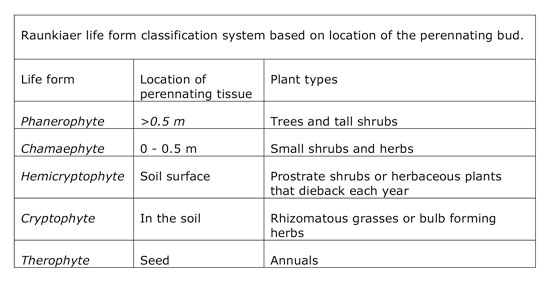
Table 1: Raunkiaer life form classification organization based on location of the perennating bud
Life forms tin can be classified past the location of perennating tissue and institute types.
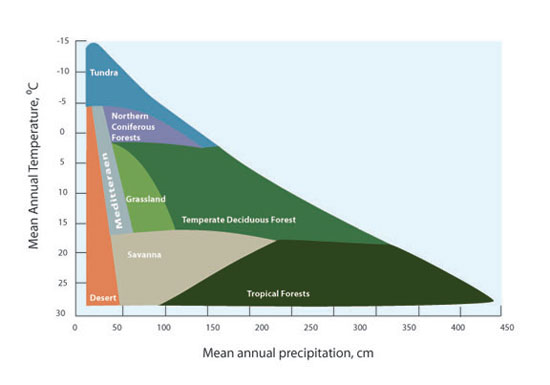
Figure 1: The distribution of vegetation types as a function of mean almanac temperature and precipitation.
Tropical Wood Biomes
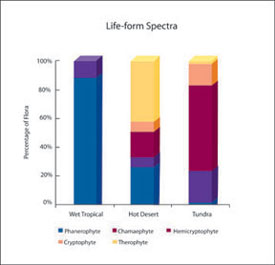
Figure two: Life-class spectra in different climates
Raunkiar classified establish life forms on traits that varied with climate, such every bit the perennating organ, or tissues that give rise to new growth the following season.
Tropical forests are establish in areas centered on the equator (Effigy 4). Central and Southward America possess half of the globe's tropical forests. Climate in these biomes shows petty seasonal variation (Figure 5), with high yearly rainfall and relatively constant, warm temperatures. The dominant plants are phanerophytes - trees, lianas, and epiphytes. Tropical rainforests take an emergent layer of tall trees over twoscore m tall, an overstory of trees up to 30 m alpine, a sub-canopy layer of copse and tall shrubs, and a footing layer of herbaceous vegetation.
Tropical forests have the highest biodiversity and chief productivity of any of the terrestrial biomes. Net chief productivity ranges from 2–3 kg chiliad-2 y-1 or college. This loftier productivity is sustained despite heavily leached, nutrient poor soils, considering of the high decomposition rates possible in moist, warm conditions. Litter decomposes rapidly, and rapid nutrient uptake is facilitated by mycorrhizae, which are fungal mutualists associated with plant roots.
The tropical forest biome is estimated to contain over half of the terrestrial species on Globe. Approximately 170,000 of the 250,000 described species of vascular plants occur in tropical biomes. As many every bit 1,209 butterfly species have been documented in 55 square kilometers of the Tambopata Reserve in southeastern Peru, compared to 380 butterfly species in Europe and North Africa combined.
The tropical forest biome is equanimous of several different sub-biomes, including evergreen rainforest, seasonal deciduous wood, tropical cloud forest, and mangrove forest. These sub-biomes develop due to changes in seasonal patterns of rainfall, elevation and/or substrate.
Savanna Biomes
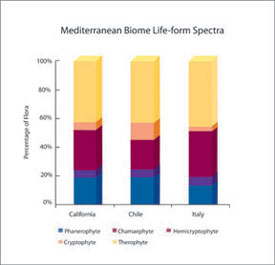
Figure 3: Life-form spectra in similar Mediterranean blazon climates on different continents
Life-form spectra are more alike in similar climates on dissimilar continents than they are in different climates on the same continent.
Located due north and south of tropical wood biomes are savannas (Figure 4), with lower yearly rainfall and longer dry out seasons (Figure half dozen). These biomes are dominated by a mix of grasses and small trees. Savannas comprehend lx% of Africa and correspond a transition from tropical forests to deserts. Trees in savannas are ordinarily drought deciduous. Several savanna types associated with differing rainfall patterns, height of the water table and soil depth can be distinguished by their relative affluence of trees and grass.
Repetitive dry season fires have occurred in the African savanna over the last 50,000 years. Burn plays a major role in the balance between trees and grasses in savannas. With long periods between fires, tree and shrub populations increase. Fires release nutrients tied upwards in expressionless constitute litter. Soil provides a expert thermal insulator, so seeds and below ground rhizomes of grasses are ordinarily protected from damage.
Net primary productivity ranges from 400–600 one thousand m-2 yr-1, but varies depending upon local conditions such as soil depth. Decomposition is rapid and twelvemonth-round, and the annual turnover rate of leaf material is high; up to sixty–80%. This turnover is aided by the rich diversity of large herbivores found in savannas, where up to threescore% of the biomass can be consumed in a given year. Dung beetles are important components of the food cycle due to their role in breaking downwardly animal droppings. The high plant eater diversity and production is mirrored past the dandy variety of predators and scavengers found in savannas.
Desert Biomes
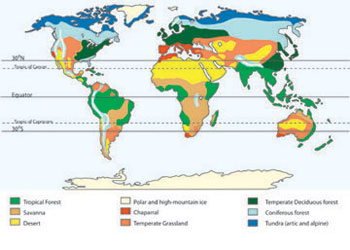
Figure 4: Biomes of the globe
Biomes are regions of similar climate and dominant found types.
Deserts generally occur in a band around the world betwixt fifteen–thirty° Northward and S latitude (Effigy 4). They embrace betwixt 26–35% of the land surface of the Globe. The climate of deserts is dominated by low precipitation, generally below 250 mm yr-1 (Effigy 7). However, there is a lot of variability in desert types, with hot deserts, cold deserts, high elevation deserts, and rain shadow deserts. Consequently, there is a great deal of variation in the biodiversity, productivity and organisms found in different types of desert.
The dominant establish biomass in almost deserts is composed of perennial shrubs with extensive roots and pocket-sized, grayness or white leaves. However, in warm deserts, therophytes (annual plants) can make up nigh of the species diversity (Effigy 2). Desert annuals tin survive unpredictable dry out periods every bit seeds. Seeds may remain viable in the soil for several years, until the appropriate rainfall and temperature weather condition occur, after which they will germinate. These annuals grow rapidly, completing their life bike in a few weeks, then flowering and setting seed before soil h2o reserves are depleted. Winter desert annuals in North American deserts can generate over 1 kg chiliad-2 of biomass in a wet year.
With the exception of big blooms of annuals, net primary productivity in most deserts is low and extremely variable. At that place is a positive human relationship betwixt productivity and precipitation, and values tin can range from near 0 to 120 1000 m-2 twelvemonth-1. But equally with savannas, productivity will vary with soil depth and local drainage patterns (east.g., washes).
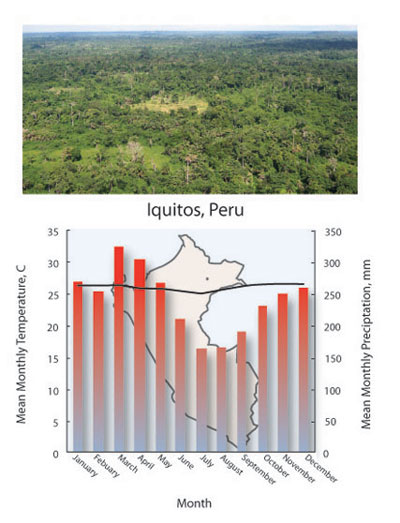
Effigy 5: Tropical forest biome climate diagram
Climate in these areas show niggling seasonal variation with high yearly rainfall and relatively constant, warm temperatures.
Grassland Biomes
Grassland biomes occur primarily in the interiors of continents (Effigy 4) and are characterized past large seasonal temperature variations, with hot summers and cold winters (Figure 8). Atmospheric precipitation varies, with a strong summer peak. The type of grassland customs that develops, and the productivity of grasslands, depends strongly upon precipitation. Higher precipitation leads to tall grass prairie with a loftier biodiversity of grasses and forbs. Lower precipitation leads to brusk grass prairies and arid grasslands.
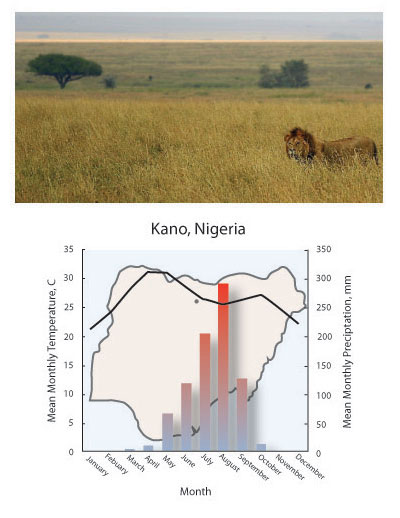
Figure 6: Savanna biome climate diagram
Savannas are located northward and south of tropical forest biomes and are characterized by lower yearly rainfall and longer dry seasons.
Net primary productivity in dry grasslands may be 400 g k-2 yr-1, while higher precipitation may back up up to one kg thou-2 yr-i. Grasslands class into deciduous forest biomes on their wetter margins, and deserts on their drier margins. The borders between grasslands and other biomes are dynamic and shift according to precipitation, disturbance, fire and drought. Burn down and drought will favor grassland over wood communities.
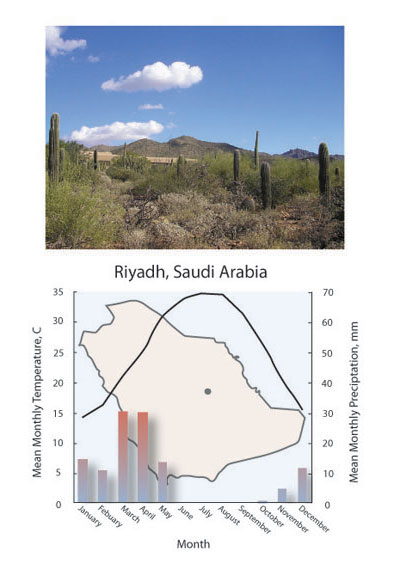
Figure 7: Desert biome climate diagram
In that location is a greater variability in desert types, with hot deserts, common cold deserts, loftier acme deserts, and rain shadow deserts.
Three major selective forces dominate the evolution of found traits in grasslands, recurring fire, periodic drought, and grazing. These factors have led to the say-so of hemicryptophytes in grasslands with perennating organs located at or beneath the soil surface. Many grasses have below ground rhizomes connecting above basis shoots or tillers. Grass blades abound from the bottom upwards, with actively dividing meristems at the base of the leaf. Thus when grazers eat the grass blade, the meristem continues to separate and the blade can continue to grow. Grasses are often decay-resistant, and recurring cool, fast moving surface fires started by lightning at the stop of summer help in nutrient recycling. Fires stimulate productivity and the germination of fire resistant seeds.
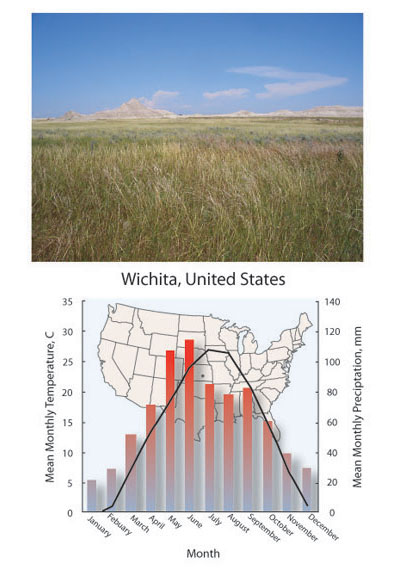
Figure eight: Grassland biome climate diagram
Grassland biomes occur primarily in the interiors of continents and are characterized by large seasonal temperature variations, with hot summers and cold winters.
Many of the world'due south largest terrestrial animals are found in grasslands. Animals such equally gray kangaroos (Macropus giganteus) in Australia, Bison (Bison bonasus) and horses (Equus spp.) in Eurasia and North America were role of species rich assemblages of grazing animals, their predators, and scavengers. Remnant herds in Due north America advise that disturbances due to grazers increased local biodiversity past creating openings that rare species could colonize. Large grazers too accelerated plant decomposition through their droppings, creating food hotspots that altered species composition.
Temperate Deciduous forest Biome
Temperature deciduous forests occur in mid-latitudes (Figure 4) where cool winters, warm summers, and high year round atmospheric precipitation occurs (Figure 9). Internet primary productivity ranges from 600–1500 yard k-ii twelvemonth-one with high litter product. Litter serves as a major pathway for nutrient recycling. This biome is named for the dominant trees that drop their leaves during the winter months. These forests may have an overstory of 20–30 m tall trees, an understory of 5–10 m trees and shrubs, a shrub layer around 1–2 m in height, and a ground layer of herbaceous plants. Biodiversity is relatively high in this biome due to the niche partitioning immune past the multiple forest layers. More circuitous forests are associated with a greater number of fauna species; for example, bird species diversity shows a positive correlation with forest height and number of layers.
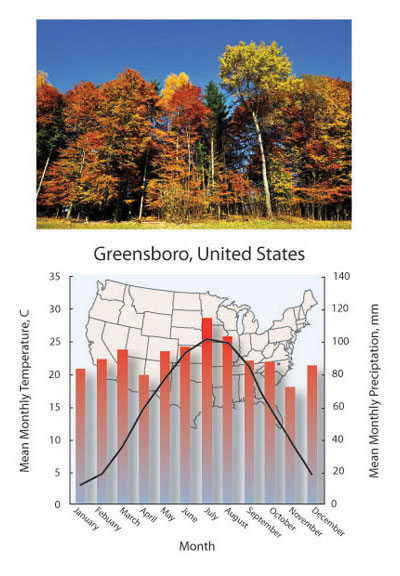
Figure ix: Temperate deciduous forest climate diagram
Temperature deciduous forests occur in mid-latitudes and are characterized by cool winters, warm summers, and high year round precipitation occurs.
Mediterranean Climate Biomes
This small biome (about 1.8 one thousand thousand square km) is separated into v separate regions between 30–xl degrees Northward and S latitude (Effigy 4) with hot, dry out summers, and cool, moist winters (Figure 10). Unrelated evergreen, sclerophyllous shrubs and trees have evolved independently in each of these areas, representing a hitting example of convergent evolution. Net principal productivity varies from 300–600 g grand-2 yr-1, dependent upon h2o availability, soil depth, and historic period of the stand up. Stand up productivity decreases after 10–20 years every bit litter and woody biomass accumulates. Recurring fires aid in nutrient cycling and many plants show fire-induced or fire-promoted flowering. Some species are able to resprout from buds protected by the soil, while others germinate from disuse-resistant seeds that lie fallow in the soil until a fire promotes their formation. Therophytes make upwards a large component of the flora, and their appearance is associated with openings created by fires.
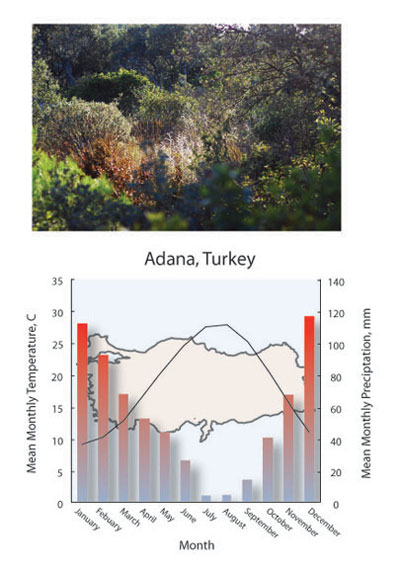
Figure ten: Mediterranean biome climate diagram
In that location are v separate regions between 30-40 degrees N and S breadth with hot, dry out summers, and absurd, moist winters.
Northern Coniferous Forest Biome
Located at higher latitudes is a biome dominated by needle-leaved, drought tolerant, evergreen trees (Figure 4), and a climate consisting of long, cold winters and curt, cool summers (Figure xi). Biodiversity is low in this 2-layered forest made up of an overstory of trees and a basis layer of herbs or mosses. The overstory in much of the boreal forest is made up of only one or two species. The low biodiversity is mirrored by depression net main productivity of 200–600 thousand m-2 year-1. Productivity varies with precipitation, the length of the frost-free flow, and local soil drainage. In flooded areas, sphagnum bogs may develop. The acidic tissue of sphagnum, and the anoxic, flooded conditions, slows decomposition, resulting in the production of peat bogs.
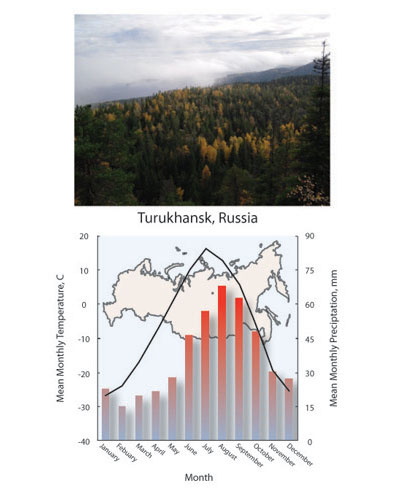
Figure eleven: Boreal wood biome climate diagram
Boreal forests are characterized by needle-leaved, drought tolerant, evergreen trees, and a climate consisting of long, common cold winters and curt, cool summers.
Biomass in tree trunks and long-lived evergreen leaves results in nutrients being stored in the plants. Low temperatures pb to slow decomposition and high litter accumulation. Up to 60% of the biomass may be tied up in litter and humus. Soils are heavily leached, and permafrost underlies much of the soil. Consequently, copse take shallow root systems and rely on extensive mycorrhizal associations for food uptake.
Tundra Biome
At latitudes beyond the boreal forest tree line lies a marshy expanse (Effigy 4) where growing seasons are very short and temperatures are below zero degrees Celsius for much of the yr (Effigy 12). Considering of these low temperatures and short growing seasons, cyberspace chief productivity is very low in the tundra, between 100–200 g yard-2 yr-1. Productivity varies with snowfall depth and local drainage. Rocky fields and dry out meadows volition have lower productivity than moist, low-lying areas and wet meadows.
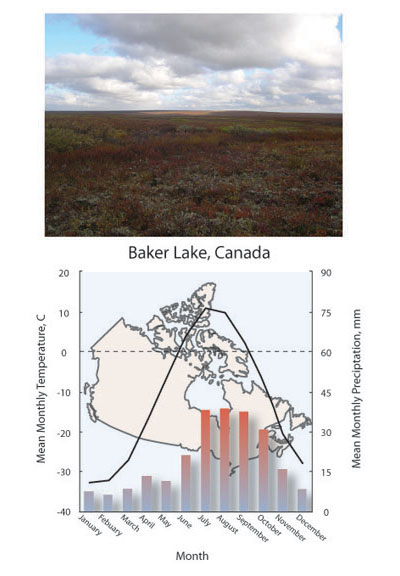
Effigy 12: Tundra biome climate diagram
Very short growing seasons and temperatures that are beneath cypher degrees Celsius for much of the yr characterize tundras.
Biodiversity in the tundra is low and dominated by mosses, lichens, and low-growing perennial shrubs. The tundra biome contains but about three% of the world's flora. Up to 60% of the flora can be made upwardly of long-lived hemicryptophytes. Windy atmospheric condition and low temperatures select for low growing shrubs, oft with tightly-packed, rounded canopies with closely spaced leaves and branches. Wind and ice damage assistance form this shape by pruning branches. The canopy morphology reduces wind speeds and absorbs solar radiation, resulting in canopy temperatures on sunny days more than 10° C higher up air temperature.
Soils are low in nutrients due to slow decomposition rates and plants retain nutrients in long-lived evergreen tissues. Nitrogen fixation by lichens with cyanobacterial components is a major source of soil nitrogen. Animals have extended hibernation periods or migrate seasonally.
References and Recommended Reading
Archbold, O. W. Ecology of Globe Vegetation. New York, NY: Chapman and Hall, 1995.
Cain, Due south. Life-forms and phytoclimate. Botanical Review sixteen, one-32 (1950).
Prentice, L. C., Cramer, W. et al. A global biome model based on establish physiology and say-so, soil properties and climate. Journal of Biogeography 19, 117-134 (1992).
Raunkiaer, C. The Life Forms of Plants and Statistical Plant Geography. Oxford, United kingdom: Clarendon Press, 1934.
Whittaker, R. H. Communities and Ecosystems. London, UK: Macmillan, 1975.
Wilson, E. O. The Diversity of Life. New York, NY: WW Norton & Co., 1999.
livingstonbusteding.blogspot.com
Source: https://www.nature.com/scitable/knowledge/library/terrestrial-biomes-13236757/
0 Response to "As You Read, Compare and Contrast the Different Biomes by Completing Each Table Below"
Post a Comment